(1)Dutch Marine Energy Centre
The European offshore energy system is in the middle of a massive transformation that is driven by the ambitious large-scale targets for offshore wind expansion. In order to ensure a sustainable long-term development of the energy system on- and offshore, it’s crucial to foster a continuous innovation. With offshore floating solar and wave energy, the EU SCORES project demonstrates the integration of two innovative offshore energy technologies in offshore wind farms. To this end, the project demonstrates the technical feasibility while addressing key stakeholder challenges and specific scenarios for the large-scale implementation of multi-use energy parks.
(1) The opportunity and challenge of offshore wind
While Europe is moving towards a fully renewable future, a lot of focus and expectations are placed on offshore renewable energies. Rightfully so, since the European seas provide a vast amount of space, as well as highly favourable conditions, especially for wind turbines. With no hills, forests or cities in the way, the wind is not only more powerful but also more predictable and consistent. This makes much larger wind turbines, of 15 and maybe even 20 MW, a possibility over the next years; despite their extreme height, they barely impact people on their everyday lives, due to their remote location, far out at sea.
Over the last years, the first offshore wind projects have reached commercial feasibility and no longer depend on government subsidies to compete with electricity prices on the energy market. These aspects have driven many European countries to commit to increasingly ambitious offshore wind targets, most recently culminating in the Oostende targets. At this meeting, the heads of state from most North Sea countries published a joint target of 120 GW of offshore wind capacity by 2050.
However, this growth does not come without complications. Even in the more stable conditions offshore, wind is still a weather phenomenon, which changes on a daily basis, and according to seasonal patterns. Together with the necessary maintenance of wind turbines, this means that, on average, a wind park will produce at around 50% of its total capacity throughout the year. Consequently, the offshore cables (accounting for 50-60% of the infrastructure costs of these projects) are only used for 50% of their capacity. With innovative technologies, this cable capacity could be used more efficiently and allow a more stable electricity supply, with a much lower additional investment.
At the same time, these patterns in wind availability also affect the stability of the electricity grid and the energy market. With the current target, and by 2050, around 80% of European electricity will come from renewable energy sources(1) . Due to this, prices are expected to reach extremes, especially during periods where only little wind occurs. A more diverse set of energy technologies could reduce these peaks by providing energy even at times when the wind does not blow.
Lastly, it’s important to point out that, despite seeming vast, offshore space is also not an unlimited resource. In busier areas, like the North Sea, there are many different activities competing for space: cargo transport, fishery, and offshore energy. With this rapid increase in activities, another crucial aspect is to ensure enough space for nature. With more areas serving for energy production, fully protected Natura 2000 areas are becoming more and more scarce. According to the current plans for wind parks, turbines will be spaced more than 1 km apart, leaving vast room for other activities.
Considering the massive changes over the upcoming years, it seems obvious that all opportunities to minimise these potential effects need to be explored. For governments, stakeholders, and commercial operators alike, it is vital to pursue the most sustainable solutions for the offshore energy system, ecosystem and the limited space available.
(2) Offshore renewable energy innovations
As a key solution to these challenges, it’s crucial to explore innovative technology solutions that play a vital role in Europe’s offshore energy system of the future. The key requirements for these technologies are (1) an easy integration in the business case of offshore energy operators, (2) the potential for co-location with offshore wind farms, without strong interference on energy yield from either technology, (3) a high technology maturity, to allow an implementation in the near future, during which spatial plans, electrical infrastructure and tenders for offshore energy projects will be designed.
Two innovative energy technologies in development are particularly well suited for these requirements.
Offshore floating solar
Floating solar panels have been operating on large water bodies, such as lakes and reservoirs, for several years. As the cheapest renewable energy source on land with an immense scaling potential, solar energy’s extension to water is a logical development for areas with little land space. Not only does this avoid disputes about the often-discussed aesthetics of onshore farms, but the available space in general is much less limited. At the same time, many existing offshore wind farm operators are already familiar with the technology from onshore PV projects. Extensive offshore tests have been pursued by several companies during the last few years. For example, Oceans of Energy from The Netherlands have operated an ever-growing number of offshore floating PV modules in the North Sea since November 2020, surviving serious winter storms. In addition, a few research organisations like SINTEF (Norway) and TNO (the Netherlands) have pursued the development of offshore solar concepts over the last years. These developments have shown that one of the core aspects in the survivability of these structures are the connection points between different modules.
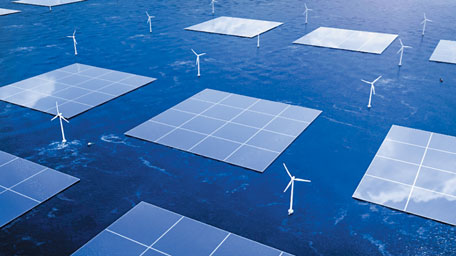
Offshore solar systems are following several different design philosophies, which are primarily distinguished by the materials used for the floaters, as well as the positioning of the panels, relative to the water surface. While some structures are designed to follow the water movement and accept overtopping waves, others are built to have the solar panels high above the sea level.
Wave Energy
Many researchers, as well as energy companies, have pursued the development of machines to extract energy from the movement of waves since the oil crisis in the 1970s. Ocean waves, which are generated by wind blowing over the surface of the sea, can travel for large distances with little to no energy loss. With a theoretical potential of 3700 GW of installed capacity, wave energy presents the largest untapped resource of renewable energy today. Extensive tests over the years of different technology concepts have taken place, for example at the European Marine Energy Centre (EMEC) in Scotland, as well as at the Wave Energy Centre (Wavec) in Portugal. One of the biggest challenges is the engineering of machines which can produce energy economically, while surviving in the harshest offshore conditions.
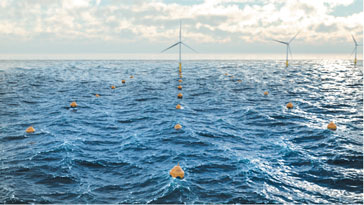
From many different device concepts, one of the best studied to date are point-absorbers. These are round or hexagonal buoys operating on the water surface or just below it, to follow the surface movement and to operate (ideally) in a state of resonance to maximise the extracted energy. Given the rotational symmetry of these devices, they operate with the same efficiency with waves from all directions, and do not need to be yawed to match the mean wave field. This reduces complexity in the design and control of the device.
The reference point for these devices to move against is the seafloor. Other concepts are based on multiple floating bodies which move relative to each other and are connected e.g., using hinges.
Given the nature of their potential, as well as associated challenges, offshore floating solar systems are best suited to operate in an environment with a low to moderate wave climate. This will enable technologies to build a strong supply chain and achieve cost reduction before stepping into more challenging waters. Obviously, for wave energy devices, the economics dictate a strong wave climate to maximise power production.
Due to this, and considering their current stage, offshore floating PV is most suited for integration in bottom fixed wind parks in the relatively shallow North Sea. To ensure high availability, these wind parks are often located in areas with a low wave climate, so that maintenance vessels can easily access the turbines.
A high-power production for wave energy devices can especially be achieved if the waves are not exclusively generated by local weather systems. With an exposure to swell from the entire Atlantic Ocean, the Atlantic coast presents an ideal environment for these devices. These areas are, in most cases (for example in Ireland and Portugal), too deep for bottom fixed wind turbine concepts. Therefore, the most likely integration scenario can be found between floating offshore wind turbines and wave energy devices.
To demonstrate the technical feasibility of wave and offshore solar energy and their integration in offshore wind parks, the EU SCORES project combines two demonstration projects.
At the Belgian coast, close to the harbour of Oostende, a 2.5 MW demonstrator of Oceans of Energy will be installed to operate in the challenging environment of steep waves in shallow water. This demonstration focuses not only on the feasibility of manufacturing, installation and operation of multi-MW offshore floating solar, but also on the integration of an export cable with onshore substations of existing offshore wind farms.
At Aguçadoura (Portugal), a wave array, consisting of three full-scale devices of CorPower Ocean, will be assembled in a mobile manufacturing unit, tested on site and deployed offshore, for a total installed capacity of 1.2 MW. Due to the proximity of the wave array to the Wind Float Atlantic offshore floating wind park, an integration with the power export cable will be implemented.
(3) The vision for multi-source offshore energy parks
Next to technical feasibility of the technologies, the key aspect of offshore multi-use is an increased power production, as well as an improved power profile. In this context, we’d like to highlight a model of the Dutch offshore wind zone Ten noorden van de Waddeneilanden (North of the Wadden islands) TNVW, which demonstrated the characteristics of a multi-use park.
The model describes potential park designs, based on the available space in the offshore wind park, and according to exclusion zones around wind turbines andmaintenance pathways.
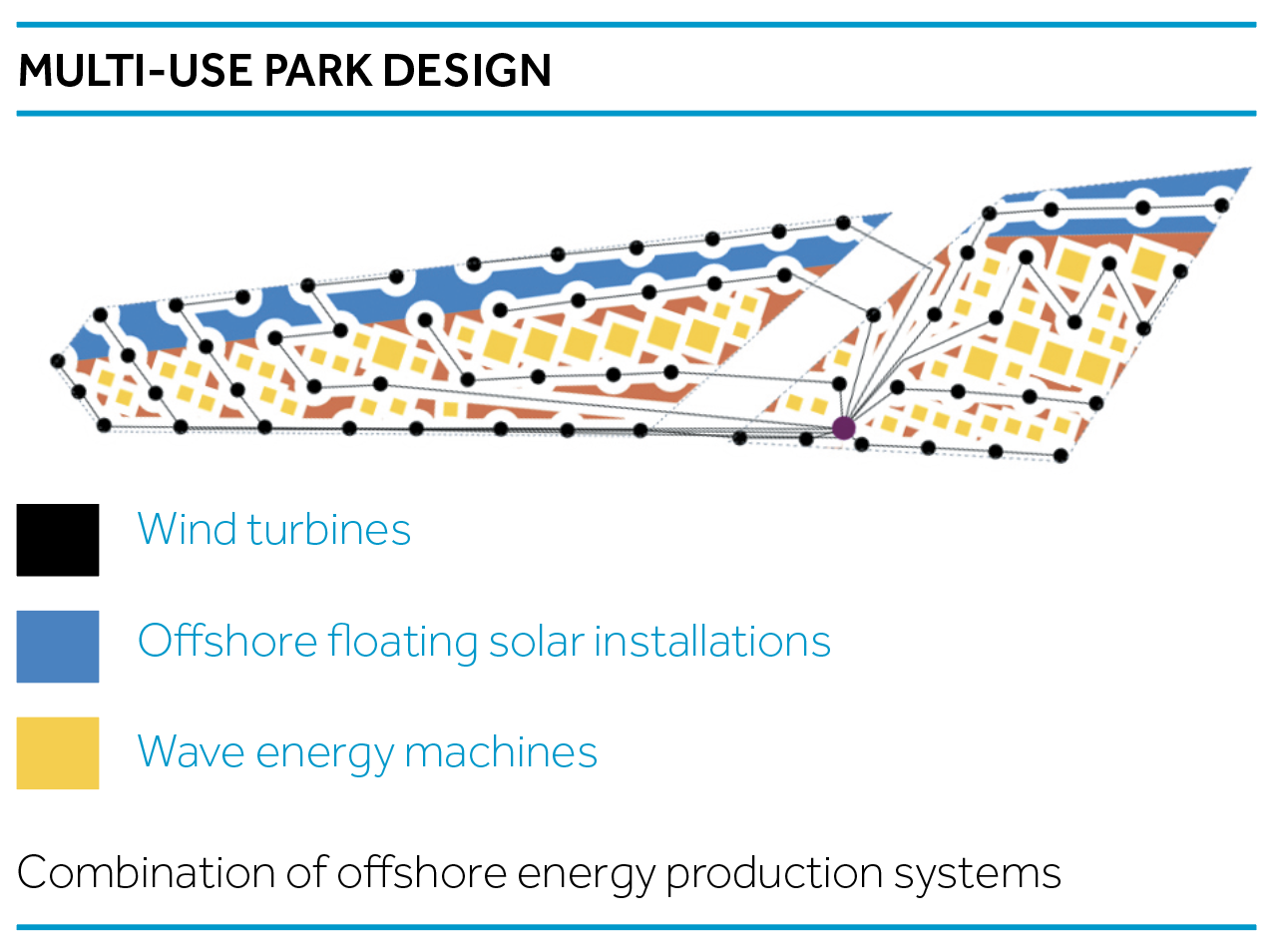
This model shows that the energy density of a floating wind zone double when integrating other technologies. In this configuration, it is possible to raise the nominal capacity of the 750 MW offshore wind park by nearly 150%, with 980 MW of offshore floating solar, and 120 MW wave energy. In a park like this, it’s possible to generate around 40% more electricity annually. But, and more importantly, longer periods with a low power output can be reduced drastically. While a pure wind park experiences around 13 events over a 3-year period, in which little to no power.
Looking at the number of times throughout a 3-year period in which only little power is available for more than 48 hours, it becomes very clear that the multi-source park is a much more reliable solution.

This shows that multi-source parks are a more efficient solution to ensure a stable power supply, even in an area with only limited wave resources. At the same time, the wave energy devices could show another positive effect on farms: while passing through the row of wave energy converters, the wave field loses energy and height. This could lead to more favourable conditions for offshore operations, namely crew transfers, or even reduce loads on the wind turbines and their foundations.
(4) The challenges addressed by EU-SCOURES
While the benefits of more efficient use of offshore space and an increased energy production are clear, it is important to address a number of challenges in the process of commercialising multi-use offshore parks.
One key aspect is the high speed with which the offshore wind project pipeline develops. Not only government tenders and cable connections, but also commercial contracts are being designed to develop and operate offshore wind projects. Adding other energy technologies, later in this process, poses challenges and might make other technologies e.g., offshore energy storage, necessary to avoid the need for additional cable capacity. In this sense, it’s crucial to promote early contact and collaboration with all stakeholders. The EU SCORES project combines a total of seven offshore wind developers to exchange challenges and lessons learned, and to support the design of legal frameworks for future multi-use parks.
On the technical side, operators and contractors need to start gaining experience with these new technologies. The safe and efficient operation of multi-use parks relies significantly on the efficiency of maintenance processes, as well as on a clearer understanding of the core risks of new technologies. Both are the result of extensive operational experience and data collection on systems operating in the offshore environment. Therefore, more and larger scale pilot projects will be a key enabler for the success of multi-use parks.
Lastly, governments, TSOs and wind farm operators must ensure that they make long term plans. With current issues around grid congestion and the need for more interconnection between European countries, wind parks are already becoming hybrids. By combining a transmission function with their energy production role, wind parks can play a dual role in enabling the energy transition. To play this role more effectively, all potential technologies and future needs, covering not only electricity generation but also storage and eco-innovation and protection of the environment, need to be part of the plan.
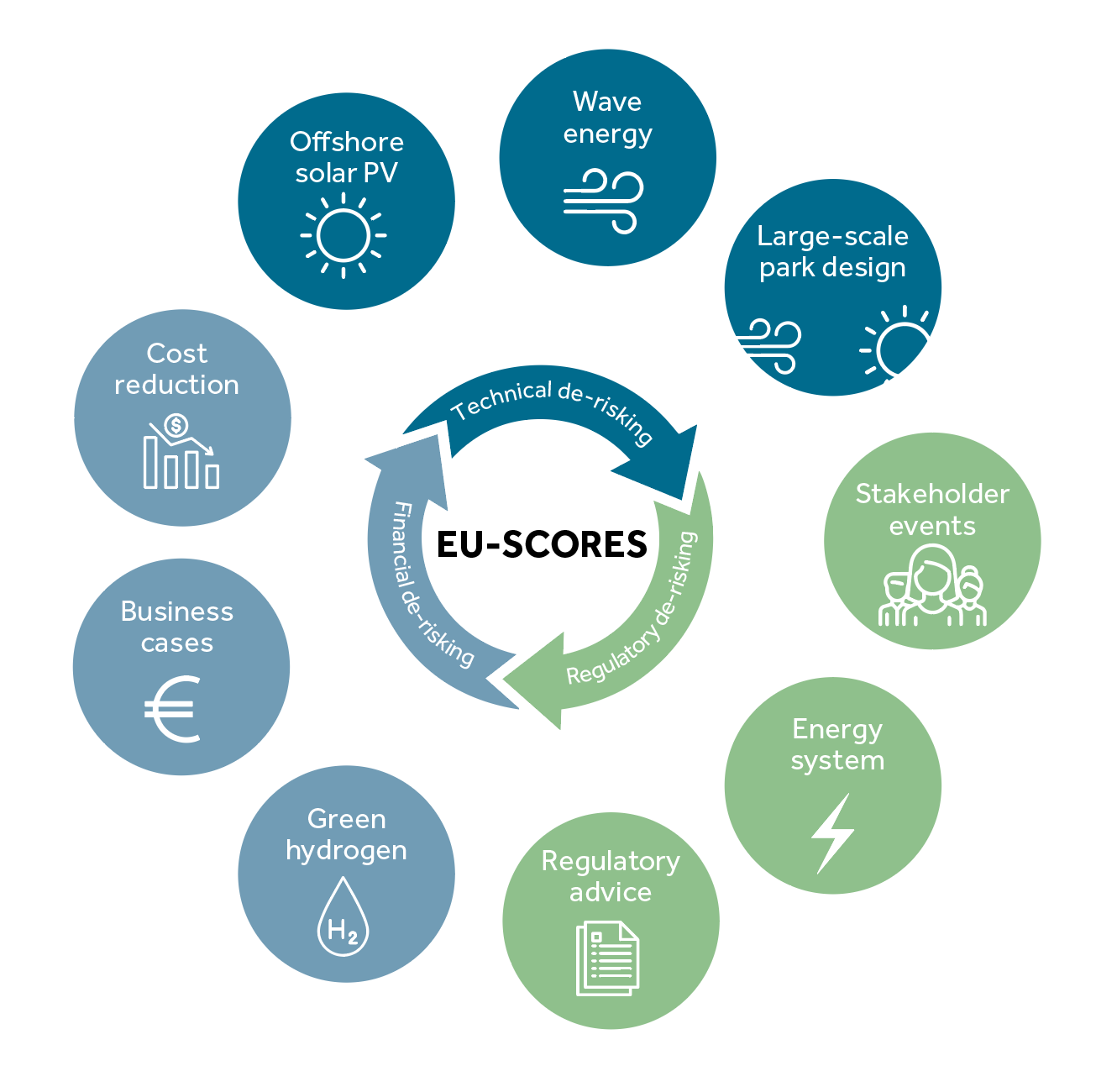
If you are interested in learning more about the EU SCORES project, following the demonstrations taking place in the project, or participating in stakeholder meetings or events, please visit www.euscores.eu or follow the project on LinkedIn.
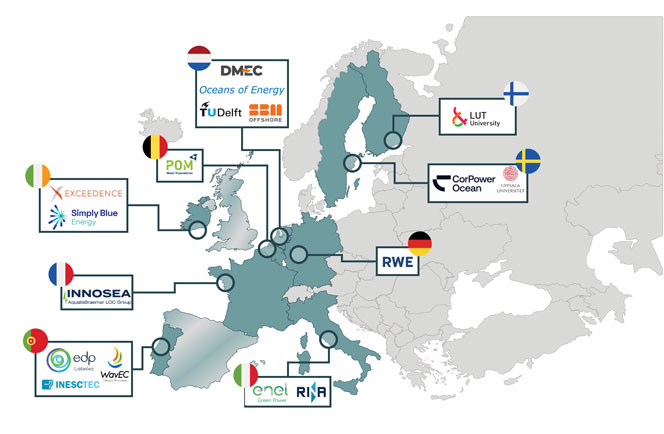
(1)DNV Energy Transition Outlook 2022